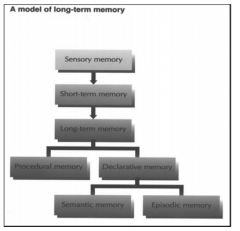![]()
![]()
![]()
Use LEFT and RIGHT arrow keys to navigate between flashcards;
Use UP and DOWN arrow keys to flip the card;
H to show hint;
A reads text to speech;
50 Cards in this Set
- Front
- Back
|
Define memory |
– involves maintaining information over time(Matlin, 1998)
- dynamic mechanisms associated with retention& retrieval of information – involves 3 operations: encoding; storage;retrieval (Sternberg, 1999) |
|
|
What does encoding involve? |
- Encoding occurs when information is firsttranslated into a form that other cognitiveprocesses can use
- It is held in storage in one form or anotherfor later retrieval |
|
|
What does retrieval involve? |
retrieval involves calling to mind of previouslystored information
|
|
|
How does forgetting occur? |
Forgetting occurs when we cannot retrieveinformation |
|
|
What activities involve memory? |
|
|
|
What metaphor did Plato use for memory? |
– an aviary – a wax tablet on which impressions are made |
|
|
What metaphors were used for memory in the middle ages and renaissance periods? |
In Middle Ages & Renaissance periods,memory was likened to
– a cave; an empty cabinet; a body in need ofexercise |
|
|
What metaphors were used for memory in the 50s? |
In 1950s, memory was likened to
– a telephone system; a computer – information processing approach |
|
|
Describe Atkinson & Shiffrin’s (1968) model |
– rehearsal: silent repetition used to maintaininformation and transfer it from STM to LTM |
|
|
Describe Sensory memory |
|
|
|
Describe short term memory (STM) |
|
|
|
Describe long term memory (LTM) |
|
|
|
What are the main claims of the Atkinson-Shiffrin model? |
|
|
|
Describe free recall tasks |
|
|
|
Describe Rundus' (1971) study |
|
|
|
What were Rundus' results? |
|
|
|
What was Rundus' interpretation? part 1 |
|
|
|
What was Rundus' interpretation? part 2 |
|
|
|
Describe Kintsch & Buschke (1969)'s experiment 1 |
Experiment 1
|
|
|
Explain Kintsch & Bushke's results |
Results of Exp. 1
|
|
|
Describe Kintsch & Buschke (1969)'s experiment 2
|
Experiment 2
|
|
|
Describe Kintsch & Buschke's results for experiment 2 |
Results of Exp. 2
|
|
|
Describe the evidence from neuropsychology |
|
|
|
Describe HM patient |
|
|
|
What evidence is there against STM-LTM distinction? |
|
|
|
What is the levels of processing approach? |
|
|
|
What are the three aforementioned levels of processing? |
|
|
|
Explain Craik & Tulving (1975)'s experiment |
- 3 types of questions about words on study list toencourage 3 different types of encoding - followed by incidental learning test – Unexpected – No prior mention of memory test |
|
|
How do you enrich semantic encoding? |
|
|
|
What are the two kinds of rehearsal? |
|
|
|
Describe the generation effect |
|
|
|
Describe Palmere et al's experiment |
|
|
|
What were Palmere et al's results |
|
|
|
What is the self reference effect? |
|
|
|
What are the strengths? |
|
|
|
What are the limitations? |
|
|
|
Describe Tulving's (1972, 1993) model |
|
|
|
What are Tulvings 3 types of knowledge? |
|
|
|
Describe the model of long term memory |

|
|
|
What are the three types of conscious experience? |
|
|
|
Describe case study 1 of the episodic-semantic distinction |
Case 1 (Gene) |
|
|
Describe case study 2 of the episodic-semantic distinction |
Case 2 (woman)
– Encephalitis => damage temporal lobe – Cannot recall meanings of common words,basic facts, historical events, famous people ... – Can remember specific events – Episodic memory intact; no semantic memory– Opposite pattern to Gene |
|
|
What do these episodic-semantic distinction cases indicate? |
|
|
|
Explain imaging studies |
|
|
|
Explain the correlational study by Underwood et al (1978) |
|
|
|
Evaluation |
|
|
|
Explain Bartlett (1932)'s schema based approach |
|
|
|
Decribe Bartlett's War of the Ghost experiment |
“The War of the Ghosts:” A Story Used byBartlett (1932) to Investigate Long-TermMemory
|
|
|
What were Bartlett's schema based model results? |
|
|
|
Describe schemas |
|

